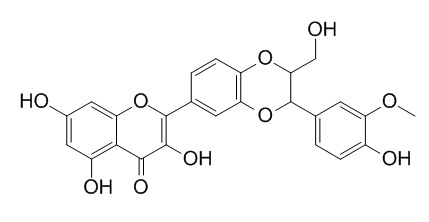2,3-Dehydrosilybin A
2,3-Dehydrosilybin A/B as a pro-longevity and anti-aggregation compound.
Inquire / Order:
manager@chemfaces.com
Technical Inquiries:
service@chemfaces.com
Tel:
+86-27-84237783
Fax:
+86-27-84254680
Address:
1 Building, No. 83, CheCheng Rd., Wuhan Economic and Technological Development Zone, Wuhan, Hubei 430056, PRC
Providing storage is as stated on the product vial and the vial is kept tightly sealed, the product can be stored for up to
24 months(2-8C).
Wherever possible, you should prepare and use solutions on the same day. However, if you need to make up stock solutions in advance, we recommend that you store the solution as aliquots in tightly sealed vials at -20C. Generally, these will be useable for up to two weeks. Before use, and prior to opening the vial we recommend that you allow your product to equilibrate to room temperature for at least 1 hour.
Need more advice on solubility, usage and handling? Please email to: service@chemfaces.com
The packaging of the product may have turned upside down during transportation, resulting in the natural compounds adhering to the neck or cap of the vial. take the vial out of its packaging and gently shake to let the compounds fall to the bottom of the vial. for liquid products, centrifuge at 200-500 RPM to gather the liquid at the bottom of the vial. try to avoid loss or contamination during handling.
Pharmacognosy Journal.2020, 12(2), p232-235.
Food Chem.2020, 332:127412
J Agric Food Chem.2024, acs.jafc.4c01387.
mBio.2020, 11(3):e00686-20.
Food Sci Biotechnol.2023, 32(9):1215-1223.
Nutrients.2022, 14(19):4170.
Front Immunol.2020, 11:598556.
Current Topics in Nutraceutical Research2021, 19(1),p90-105.
Toxicol In Vitro.2018, 52:94-105
Biomed Pharmacother.2019, 116:108987
Related and Featured Products
Free Radical Biology and Medicine, 2017, 103(Complete):256-267.
2,3-Dehydrosilybin A/B as a pro-longevity and anti-aggregation compound.[Reference:
WebLink]
Aging is an unavoidable process characterized by gradual failure of homeostasis that constitutes a critical risk factor for several age-related disorders. It has been unveiled that manipulation of various key pathways may decelerate the aging progression and the triggering of age-related diseases. As a consequence, the identification of compounds, preferably natural-occurring, administered through diet, with lifespan-extending, anti-aggregation and anti-oxidation properties that in parallel exhibit negligible side-effects is the main goal in the battle against aging.
METHODS AND RESULTS:
Here we analyze the role of 2,3-Dehydrosilybin A/B (DHS A/B), a minor component of silymarin used in a plethora of dietary supplements. This flavonolignan is well-known for its anti-oxidative and neuroprotective properties, among others. We demonstrate that DHS A/B confers oxidative stress resistance not only in human primary cells but also in the context of a multi-cellular aging model, namely Caenorhabditis elegans (C. elegans) where it also promotes lifespan extension.
CONCLUSIONS:
We reveal that these DHS A/B outcomes are FGT-1 and DAF-16 dependent. We additionally demonstrate the anti-aggregation properties of DHS A/B in human cells of nervous origin but also in nematode models of Alzheimer's disease (AD), eventually leading to decelerated progression of AD phenotype. Our results identify DHS A/B as the active component of silymarin extract and propose DHS A/B as a candidate anti-aging and anti-aggregation compound.
Planta Med 2013; 79 - P37.
Flavanolignans from Silybum marianum L. – Chemistry and Characterization as Primary Phyproof® Reference Substances.[Reference:
WebLink]
Since ancient times milk thistle (Silybum marianum L.) fruits are known to have medicinal properties. Cultivation began more than 2000 years ago and was especially popular in Germany, Greece and Italy. The active principal is a mixture of various flavanolignans known as silymarin, located in the pericarp and isolated and structurally characterized for the first time in the 1960 s. Recognized medicinal application areas are the supportive treatment of chronic inflammatory liver disorders and cirrhosis of the liver as well as the intravenous treatment of toxic liver damage (e.g. Amanita mushroom poisoning). Completely new areas of application opened up in the 1990 s after it was discovered that silymarin and isolated flavanolignans inhibited the spread of tumor cells.
METHODS AND RESULTS:
According to the Pharmacopoea Europaea silymarin is a mixture of silybin A and B, isosilybin A and B, silychristin and silydianin. These flavanolignans originate biosynthetically from the radical oxidative coupling of taxifolin with coniferyl alcohol. Resulting products are characterized by the flavanolignan skeleton with the molecular formula C15H22O10 and a molecular weight of 482.4 g/mol. Due to its low stereoselectivity this reaction produces trans-configured diastereoisomeric pairs. To distinguish the A and B forms measurement of optical rotation and CD spectra are required, while identification based on HPLC retention times alone is error-prone. It is noteworthy that the pharmacological activity and mode of action of the various diastereoisomers differs significantly.
CONCLUSIONS:
The isolated flavanolignans silybin A and B, isosilybin A and B, silychristin, silydianin as well as 2,3-Dehydrosilybin A and 2,3-dehydrosilybin B were characterized as primary reference substances according to international guidelines. These compounds, now available in a certified quality for the first time, can be applied in the quality control of milk thistle preparation as well as in pharmacological research. They will hopefully assist in broadening the knowledge on these fascinating natural compounds.



